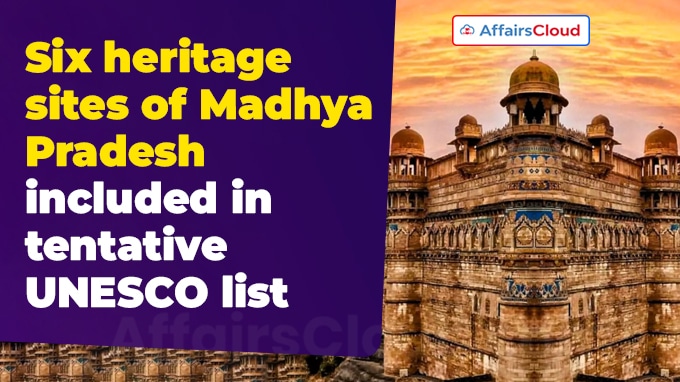 Six heritage sites in Madhya Pradesh (MP) were included in the tentative list of the United Nations Educational, Scientific and Cultural Organization (UNESCO) World Heritage Sites (WHS).
Six heritage sites in Madhya Pradesh (MP) were included in the tentative list of the United Nations Educational, Scientific and Cultural Organization (UNESCO) World Heritage Sites (WHS).
- The six sites are Gwalior Fort, Khooni Bhandara, Bhojeshwar Mahadev Temple, the Rock art sites of Chambal Valley, the historic ensemble of Dhamnar, and the Gond monuments of Ramnagar.
Gwalior Fort:
i.Gwalior Fort is also known as the ‘Gibraltar of India’, located in the Gwalior district of Madhya Pradesh.
ii.It is mentioned as ‘Gopachala, Gopagiri’ and other allied names, all meaning ‘cowherds’ hill, in the old Sanskrit inscriptions.
iii.The first foundation of Gwalior Fort was laid by Rajput warrior Suraj Sen of the Tomar Dynasty in the 6th century AD.
iv.Monuments inside the fort complex include Mansingh Palace (Man Mandir Palace), Gujari Mahal, Teli-ka-Mandir, Sas-Bahu Temples, Chaturbhuj Temple, Jain Tirthankaras, and Gurudwara Data Bandi Chhod.
Khooni Bhandara, Burhanpur:
i.‘Khooni’ or ‘Kundi Bhandara’ is an underground water management system comprising eight interconnected waterworks located in Burhanpur, MP.
ii.It was built by Abdur Rahim Khan-i-Khanan in 17th century AD, the Subedar of Burhanpur, during the reign of Jahangir.
Bhojeshwar Mahadev Temple:
i.Bhojeshwar Mahadev Temple, dedicated to Lord Shiva, is located on the banks of the Betwa River in the Raisen District of MP.
ii.It is a single-stone carved temple and is also known as the ‘Somnath of East.’
iii.It was built during the 11th century under the patronage of Raja Bhoj of the Paramara dynasty. Raja Bhoj was known for his architectural treatise, Samaranganasutradhara.
iv.The temple’s architecture follows the Bhumija style, characterized by its towering shikhara and ornate carvings and sculptures.
v.The linga in the sanctum sanctorum is 2.35 metres long with a circumference of about 6 metres.
Rock Art Sites of the Chambal Valley:
i.These rock art sites are expanded into 9 Clusters of various districts of Madhya Pradesh & Rajasthan.
ii.The Chambal Basin and Central India region contain the largest concentration of known rock art sites in the world.
The historic ensemble of Dhamnar:
i.The Dhamnar caves spread across a span of 5.2 hectares, are located in Dhamnar village of Mandsaur district, MP.
ii.It was built in the 7th century AD.
iii.This rock-cut site consists of a total of 51 caves (14 larger caves and 37 smaller caves) carved into the laterite hill.
iv.The hill consists of two groups of structures, the series of Buddhist caves and the hindu temple complex known as the Dharmarajeshwara temple, also called Dharmanath temple.
v.The caves consist of dwellings, halls of various sizes, stupas, and statues of Buddha in rare postures
Gond monuments of Ramnagar:
i.It is a cluster of monuments including Moti Mahal (Rajmahal), Raibhagat ki Kothi, Vishnu Mandir (Suraj mandir), Begum Mahal, and Dalbadal Mahal.
ii.Ramnagar in the Mandla district of MP used to be the stronghold of the Gond rulers who ruled over Gondwana or “the Land of the Gonds’’ which is in the present-day states of Madhya Pradesh, Chhattisgarh, and Maharashtra.
iii.Moti Mahal was built by Hirde Shah on the bank of river Narmada in 1667.
About Tentative UNESCO List:
i.The Tentative list consists of sites that can be either cultural or natural areas or objects for having outstanding universal value.
ii.The heritage sites in the Tentative list will be considered for nominations to the UNESCO World Heritage List.
iii.As of 21st March 2024, India has 57 sites in UNESCO’s Tentative list of heritage sites.
Recent Related News:
Santiniketan in West Bengal(WB) and Sacred Ensembles of the Hoysalas in Karnataka were inscribed on the United Nations Educational, Scientific and Cultural Organization (UNESCO) World Heritage list.
About United Nations Educational, Scientific and Cultural Organization(UNESCO):
Director-General – Audrey Azoulay
Headquarters – Paris, France
Established in – 1945 (came into force in 1946)




